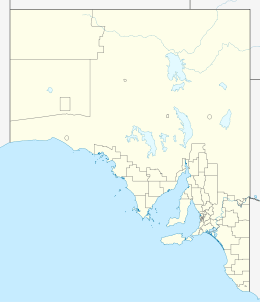Cape Banks
| Cape Banks South Australia | |
|---|---|
 Cape Banks | |
| Coordinates | 37°55′8″S 140°23′49″E / 37.91889°S 140.39694°ECoordinates: 37°55′8″S 140°23′49″E / 37.91889°S 140.39694°E |
| Elevation | 15 m (49 ft)[1] |
| Location | 36 km (22 mi) west south-west of Mount Gambier |
Cape Banks is a headland located at the south end of Bucks Bay and the north end of Bungaloo Bay on the south east coast of South Australia about 36 kilometres (22 mi) west south west of the city of Mount Gambier. The cape is described by one source as being ‘a rocky point, 15m 15 metres (49 ft) high, 24 nautical miles (44 km; 28 mi) miles SSE of Cape Buffon’ while another source describes it as ‘a cuspate foreland protruding 500 metres (1,600 ft) seaward in lee of calcarenite rocks and reefs’. It was named by the Royal Navy officer, James Grant, on 3 December 1800. A settlement known as Carpenter Rocks is located about 1 kilometre (0.62 mi) to the north west of the cape. [1][2][3][4][5][6]
References
- 1 2 National Geospatial-Intelligence Agency (2010). Pub175, Sailing directions (enroute) north, west, and south coast of Australia (PDF) (10th ed.). National Geospatial-Intelligence Agency (NGA). p. 219. Retrieved 16 May 2014.
- ↑ "Cape Banks UNPATROLLED BEACH". Surf Life Saving Australia. Retrieved 25 November 2014.
- ↑ "Banks, Cape". State Library of South Australia. Archived from the original on 4 April 2015. Retrieved 25 November 2014.
- ↑ "Cape Banks". Gazetteer of Australia online. Geoscience Australia, Australian Government.
- ↑ South Australia. Department of Marine and Harbors (1985), The Waters of South Australia a series of charts, sailing notes and coastal photographs, Dept. of Marine and Harbors, South Australia, pp. Chart 1, ISBN 978-0-7243-7603-2
- ↑ Boating Industry Association of South Australia (BIA); South Australia. Department for Environment and Heritage (2005), South Australia's waters an atlas & guide, Boating Industry Association of South Australia, p. 178, ISBN 978-1-86254-680-6
This article is issued from Wikipedia - version of the 11/14/2016. The text is available under the Creative Commons Attribution/Share Alike but additional terms may apply for the media files.